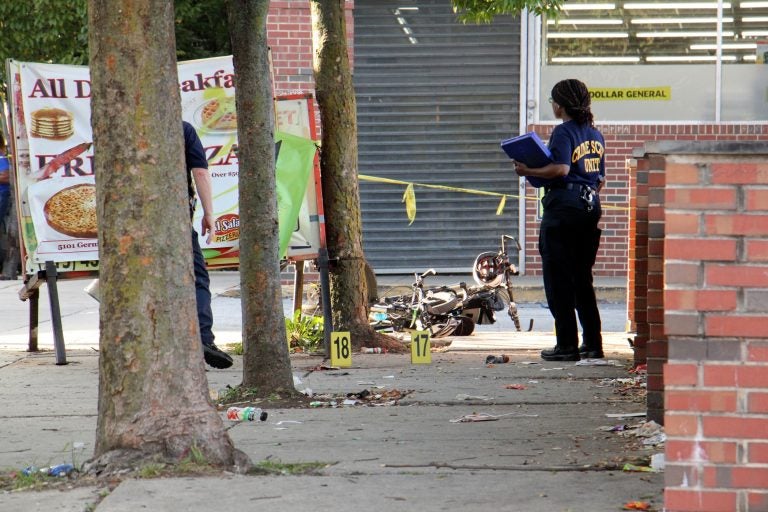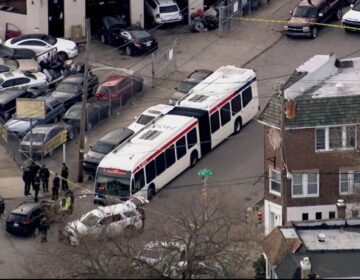Homicide and home values: Why the city controller says Philly needs a fiscal argument to combat murder rate
A new report says that murder in Philadelphia hurts home values. And its authors think the city needs to hear that message to prompt real change.

Police investigate a 2018 drive-by shooting in Germantown. The City’s Controller has found that a homicide reduces the values of a nearby homes. (Emma Lee/WHYY)
Reducing gun violence in Philadelphia is a widely acknowledged moral imperative.
But does it also make good economic sense?
That’s the argument laid out in a new report by the Office of the City Controller. It found that a single homicide in Philadelphia reduces the value of homes sold within 0.75 miles of the murder by an average of 2.3%, compared to homes purchased slightly farther away.
“Our results suggest homeowners who sold in the immediate aftermath of a homicide received a price about $3,400 lower than they otherwise would have if the homicide [had] not occurred,” the Controller’s Office concluded.
By looking at more than 4,000 homicides and 220,000 home sales in Philadelphia between 2006 and 2018, the Controller’s Office says it can now put a number behind the accepted wisdom that “when a homicide occurs, it negatively impacts the perception of safety in a neighborhood.”
The new analysis — which was conducted independently by the City Controller’s Office and reviewed by three academic researchers — uses that mathematical assertion to argue that targeted violence-reduction efforts could pay for themselves through increased tax revenue.
“There is a return on investment from a financial standpoint,” said City Controller Rebecca Rhynhart. “That return on investment is great and could allow us to invest in this city and bring the whole city up. I know that sounds idealistic, but it’s possible.”
If the city could reduce homicides by 10%, the report says, the resulting increase in property values would generate an extra $13 million in property tax revenue. And if Philadelphia maintains that pace for five years straight, an extra $114 million would flow to city coffers.
With a problem as intractable and generational as gun violence, it’s hard to know if Philadelphia could achieve that kind of reduction in homicide. But Rhynhart’s office recommends a trio of “evidence-based” strategies that it believes could lead to a dramatic drop in violent deaths.
Those strategies — which have been tested in other cities, the report says — include targeted “hot spot” policing, group counseling, and the deployment of community activists to intervene in neighborhood disputes.
The City Controller’s Office says faithful implementation of these approaches would cost $43 million over the next five years.
“A properly funded and implemented multi-pronged strategy could lead to a 35% reduction in homicides over five years, saving 318 lives,” according to the office’s analysis. “It would reduce the homicide count to 230, a historic low for Philadelphia.”
But is an economic case for gun-violence reduction even necessary? Shouldn’t the untimely death of 350 Philadelphians each year be enough to prompt action? Who cares about the return on investment?
Rhynhart hopes the new numbers will help people understand the citywide toll of Philadelphia’s homicide rate. She believes this analysis can reach people who don’t feel the everyday scourge of gun violence, which is highly concentrated in a handful of disadvantaged neighborhoods.
“If people aren’t convinced enough from a moral argument, from a humanity argument, well then here’s a financial argument,” Rhynhart said.
Caterina Roman, a Temple University professor who reviewed the report before its release, said that unfortunately too many people don’t feel the urgency of Philadelphia’s violence epidemic. Some of those people, she said, think “these are young black men shooting young black men, not educated, they’re just fighting amongst themselves. Why should it be our problem?”
By arguing that homicides hurt home values — and thus depress the city’s tax base — this latest research gives “the public in general a broader lens that it does affect everybody,” Roman said.
More broadly, she added, it’s important for people to understand that homicide has financial and societal costs beyond those imposed by the criminal justice system.
Harvard researcher Thomas Abt — who is cited in the study, but did not review it — believes policy makers need to use whatever arguments they can to prompt anti-violence action. “I’m a pragmatist. And whatever convinces and motivates people to action is what I’m in favor of,” he said.
Philadelphia’s homicide rate has gone up 41% since 2013, and Philly now has the highest murder rate among the nation’s 10 largest cities. In 2018 alone, 351 Philadelphians were murdered. Of those 351 homicides, 83% involved guns.
Rhynhart suggested that Philadelphia model its anti-violence initiatives on an effort in Oakland called “Operation Ceasefire” and another in New Orleans named “NOLA for Life.” The New Orleans program earned plaudits for driving down murder rates, but there have been more recent questions about the long-term sustainability of the strategies.
Among the stickier points in Rhynhart’s plan could be its use of “focused deterrence,” a carrot-and-stick approach that targets the “small group of people” considered most likely to commit future homicides. When implemented well, Rhynhart said, the strategy gives those people a “way out” of criminal circles through social services and jobs. If they refuse that help, law enforcement is supposed to take swift legal action.
District Attorney Larry Krasner has expressed some skepticism of the approach, saying that too often the crackdown side of the equation gets more heft than the uplift side. But he has indicated an openness to the idea in recent months.
Rhynhart said that she spoke with Krasner about the plan for roughly an hour and that the DA “reaffirmed his commitment to wanting to do these three programs.”
The new data from the Office of the City Controller updates a 2012 study from the Center for American Progress, a left-leaning think tank. The 2012 analysis studied the economics of homicide in eight cities, including Philadelphia.
WHYY is your source for fact-based, in-depth journalism and information. As a nonprofit organization, we rely on financial support from readers like you. Please give today.







